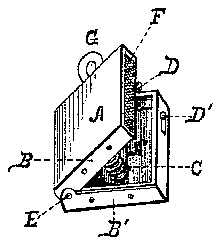
- 1spring
Description
(No Model.)
v W/T/VESSBF J. H. OROWELL. FINGER NAIL CUTTER.
Patented D60. 9, 1890.
UNTTED STATES PATENT QFFICE.
JOIIN II. CROIVELL, OF VINEYARD HAVEN, MASSACHUSETTS.
FINGER-NAIL CUTTER.
SPECIFICATION forming part of Letters Patent No. 442,247, dated December 9, 1890.
Application filed February 1, 1889, Serial No. 298,417. (No model.)
To all whom, it may concern;
Be it known that I, JOHN H. CRoWELL, a citizen of the United States, residing at Vineyard Haven, in the county of Dukes and State of Massachusetts, have invented a new and useful Finger-Nail Cutter, of which the following is a specification.
My invention relates to an improvement in arranging and operating cutters for the purpose of cutting finger-nails; and the object of my improvement is to so arrange cutters and mechanism that an article can be constructed for cutting finger'nails that will be compact, effective, convenient, and, if desired, an ornament.
I attain the object of my in'iprovement by the mechanism and construction illustrated in the accompanying drawing, in which the figure is a view in perspective.
A A are two concave or box sections, which are hinged together at their side, so as to turn on a pin, the end of which is seen at E.
To one and the corresponding side of each of the flat or shallow hinged sections A A are secured, respectively, the cutters B B, which are also hinged together and turn with the said sections A A on the pin E, though it is not essential to the successful operation of the said cutters that they be hinged together, for by being attached to the said hinged sections they will jointly operate with said sections; but in the present instance I prefer to have them hinged.
(J is a helical spring placed between the hinged sections A A for the purpose of opening or returning the said sections with their cutters to a predetermined position from which they have been shut together in the operation of cutting or shearing off the finger-nails. Said predetermined position is that of limiting the opening of the said outters by the length of the said: spring 0 to that of about one-quarter of an inch at the end of the cutters farthest from the hinge E. Thus the spring by being placed between the sections causes them to become what I shall hereinafter term them, limited yielding hinged sections.
D is a catch, into which the bolt D is slid (when desired) for the purpose of holding the limited yielding hinged sections when closed together.
F is a file-cutter attached to the side of the section A, on which the finger-nails can be cut finer or smoother after having been cut with the cutters B B.
G is a ring secured to the finger-nail cutter, by means of which the said finger-nail cutter as an article can be connected for convenience to ones watch'chain or any accessible portion of ones wearing-apparel.
The advantages of my improvement in finger-nail cutters over any I know of are as follows: First, the cutters by being secured to two flat or shallow box-sections admit of presenting very large and convenient surfaces to the fingers (which is the power used) in operating the said cutters when cutting the finger-nails; second, I produce an article that is not cumbersome and can be easily carried about the person.
What I claim as my invention, and desire to secure by Letters Patent, is
The herein-described finger-nail cutter, consisting of the fiat or shallow sections A A, hinged at E, and which are provided with cutters B B, the spring (1, made so as to limit the opening of said sections to a predetermined position, the ring G, the catch-bolt D D, and the tile F, substantially as herein set forth.
JOHN H. UROWELL.
Witnesses:
S. F. CRowELL, A. CRowELL.